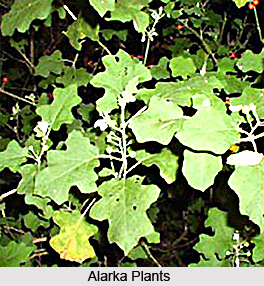 Alarka, an essential and indigene medicinal plant goes by its Botanical synonym of Asclepias procera. However, Alarka is somewhat popular with the English names like Dead Sea apple, milkweed, sodom apple, swallow-wort; Hindi names like ak, akada, akaua, akua, madar, mudar, safed ak; Oriya names like orka; Sanskrit names like arka; and Telegu names like chinna jilleedu, jelledu, mandaramu, nallajilledu. The Indian medicinal plant Alarka is wholly native to India, common on a variety of soils almost throughout the country. It can be found to bloom in an altitude of 1000 metres, ranging from places like Punjab and Rajasthan to West Bengal and Assam and even southwards through peninsular India. However, Alarka is conspicuously absent in Kerala. The plant occurs in open habitats like cultivated fields, roadsides, grazing lands and other disturbed or degraded sites throughout the drier parts of its range.
Alarka, an essential and indigene medicinal plant goes by its Botanical synonym of Asclepias procera. However, Alarka is somewhat popular with the English names like Dead Sea apple, milkweed, sodom apple, swallow-wort; Hindi names like ak, akada, akaua, akua, madar, mudar, safed ak; Oriya names like orka; Sanskrit names like arka; and Telegu names like chinna jilleedu, jelledu, mandaramu, nallajilledu. The Indian medicinal plant Alarka is wholly native to India, common on a variety of soils almost throughout the country. It can be found to bloom in an altitude of 1000 metres, ranging from places like Punjab and Rajasthan to West Bengal and Assam and even southwards through peninsular India. However, Alarka is conspicuously absent in Kerala. The plant occurs in open habitats like cultivated fields, roadsides, grazing lands and other disturbed or degraded sites throughout the drier parts of its range.
The Indian medicinal plant Alarka bears within itself specific fundamental qualities of being hardy, erect and appears like a pubescent evergreen shrub with soft and corky bark. Alarka is very similar in appearance to Calotropis gigantea, but is distinguished by its more compact form, of more oblong leaves. The plant`s flowers emanate a strong fragrance, with its leaves bearing characteristics of being broadly elliptical in shape, ovate-oblong, elliptic or obovate, acute or mucronate, slightly cordate and auricled at base. In its young stages, Alarka is pretty cottony and pubescent; however, with passing years the Indian medicinal plant turns glabrous. The plant possesses a length varying between 5 to 23 centimetres and breadth within 4 to 9 centimetres. The outer appearance of Alarka is wide, pale green in the above and white and tawny beneath.
Flowers of the Alarka medicinal plant varies from white to pink in colour and is also spotted or tinged with purple. Its corolla lobes appear erect and silvery from outside with a strong odour; its flowers are borne in long-peduncled umbellate cymes which are cottony-pubescent in its young stages. This specific Indian medicinal plant`s fruits or follicle appear as sub-globose, ellipsoid or ovoid, which are re-curved is generally 10 to 14 centimetre in length. Alarka bears numerous seeds that are ovoid, acute and narrowly margined. The seeds are light brown in colour, with a white tuft of silky hair (coma) at the pointed end. Flowers and fruits of Alarka blossom almost throughout the year and are primarily found in central Indian deciduous forests. Flowering occurs largely from December to February and fruiting between February and April.
Alarka is a cardinal Indian medicinal plant that quite palpably bears umpteen medicative properties and uses. The parts of the plant used and their medicinal properties are the same as those for Calotropis gigantea. The root bark of both species finds official usage in the Indian Pharmacopoeia. In southern West Bengal, a paste prepared from the roots mixed with leaves of Ocimum sanctum (Lamiaceae) is administered to treat menorrhagia. The root bark of Alarka is reportedly used in the treatment of leprosy among the Rabaris in the Barda Hills of Gujarat. In north-eastern Karnataka, fresh leaves of Alarka are administered as an antidote to snake bite; in this region, the flower buds blended with black pepper (fruits of Piper nigrum: Piperaceae) are given to relieve fever accompanied by shivering. Among the tribal inhabitants of Prakasam District in southern Andhra Pradesh, a paste of the dried Alarka flowers is administered orally to treat gonorrhoea. The flowers, mixed with honey, are apparently used by rural inhabitants of Bhavnagar District in Gujarat to cure cold, asthma and cough. In this region the latex of Alarka is also used to prepare a paste with boiled milk and sugar that is taken internally as an anti-malarial drug.



















